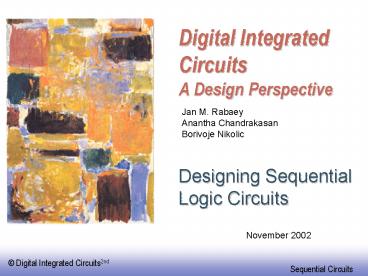Digital Integrated Circuits A Design Perspective - PowerPoint PPT Presentation
1 / 60
Title:
Digital Integrated Circuits A Design Perspective
Description:
For instance, many books call edge-triggered elements flip-flops ... Non-Bistable Sequential Circuits. Schmitt Trigger. VTC with hysteresis. Restores signal slopes ... – PowerPoint PPT presentation
Number of Views:171
Avg rating:3.0/5.0
Title: Digital Integrated Circuits A Design Perspective
1
Digital Integrated CircuitsA Design Perspective
Jan M. Rabaey Anantha Chandrakasan Borivoje
Nikolic
Designing SequentialLogic Circuits
November 2002
2
Sequential Logic
2 storage mechanisms
positive feedback
charge-based
3
Naming Conventions
- In our text
- a latch is level sensitive
- a register is edge-triggered
- There are many different naming conventions
- For instance, many books call edge-triggered
elements flip-flops - This leads to confusion however
4
Latch versus Register
- Latch
- stores data when clock is low
- Register
- stores data when clock rises
D
Q
D
Q
Clk
Clk
Clk
Clk
D
D
Q
Q
5
Latches
6
Latch-Based Design
- N latch is transparentwhen f 1
- P latch is transparent when f 0
f
N
P
Logic
Latch
Latch
Logic
7
Timing Definitions
CLK
Register
t
D
Q
t
t
hold
su
D
DATA
CLK
STABLE
t
t
c
q
2
Q
DATA
STABLE
t
8
Characterizing Timing
Latch
Register
9
Maximum Clock Frequency
Also tcdreg tcdlogic gt thold tcd
contamination delay minimum delay
tclk-Q tp,comb tsetup T
10
Positive Feedback Bi-Stability
1
1
o
o
V
V
5
2
i
V
1
o
V
5
2
i
V
11
Meta-Stability
Gain should be larger than 1 in the transition
region
12
Writing into a Static Latch
Use the clock as a decoupling signal, that
distinguishes between the transparent and opaque
states
Forcing the state (can implement as NMOS-only)
Converting into a MUX
13
Mux-Based Latches
Negative latch (transparent when CLK 0)
Positive latch (transparent when CLK 1)
CLK
14
Mux-Based Latch
15
Mux-Based Latch
NMOS only
Non-overlapping clocks
16
Master-Slave (Edge-Triggered) Register
Two opposite latches trigger on edge Also called
master-slave latch pair
17
Master-Slave Register
Multiplexer-based latch pair
18
Clk-Q Delay
19
Setup Time
20
Reduced Clock Load Master-Slave Register
21
Avoiding Clock Overlap
X
CLK
CLK
Q
A
D
B
CLK
CLK
(a) Schematic diagram
CLK
CLK
(b) Overlapping clock pairs
22
Overpowering the Feedback Loop -Cross-Coupled
Pairs
NOR-based set-reset
23
Cross-Coupled NAND
Added clock
Cross-coupled NANDs
This is not used in datapaths any more,but is a
basic building memory cell
24
Sizing Issues
Output voltage dependence on transistor width
Transient response
25
Storage Mechanisms
Dynamic (charge-based)
Static
CLK
D
Q
CLK
26
Making a Dynamic Latch Pseudo-Static
27
More Precise Setup Time
28
Setup/Hold Time Illustrations
Circuit before clock arrival (Setup-1 case)
29
Setup/Hold Time Illustrations
Circuit before clock arrival (Setup-1 case)
30
Setup/Hold Time Illustrations
Circuit before clock arrival (Setup-1 case)
31
Setup/Hold Time Illustrations
Circuit before clock arrival (Setup-1 case)
32
Setup/Hold Time Illustrations
Circuit before clock arrival (Setup-1 case)
33
Setup/Hold Time Illustrations
Hold-1 case
0
34
Setup/Hold Time Illustrations
Hold-1 case
0
35
Setup/Hold Time Illustrations
Hold-1 case
0
36
Setup/Hold Time Illustrations
Hold-1 case
0
37
Setup/Hold Time Illustrations
Hold-1 case
0
38
Other Latches/Registers C2MOS
Keepers can be added to make circuit
pseudo-static
39
Insensitive to Clock-Overlap
V
V
V
V
DD
DD
DD
DD
M
M
M
M
2
6
2
6
M
0
0
M
4
8
X
X
D
Q
D
Q
M
1
M
1
3
7
M
M
M
M
1
5
1
5
(a) (0-0) overlap
(b) (1-1) overlap
40
Pipelining
Pipelined
Reference
41
Other Latches/Registers TSPC
Negative latch (transparent when CLK 0)
Positive latch (transparent when CLK 1)
42
Including Logic in TSPC
Example logic inside the latch
AND latch
43
TSPC Register
44
Pulse-Triggered LatchesAn Alternative Approach
Ways to design an edge-triggered sequential cell
Master-Slave Latches
Pulse-Triggered Latch
L1
L2
L
Data
Data
D
Q
D
Q
D
Q
Clk
Clk
Clk
Clk
Clk
45
Pulsed Latches
46
Pulsed Latches
Hybrid Latch Flip-flop (HLFF), AMD K-6 and K-7
47
Hybrid Latch-FF Timing
48
Latch-Based Pipeline
49
Non-Bistable Sequential Circuits-Schmitt Trigger
- VTC with hysteresis
- Restores signal slopes
50
Noise Suppression using Schmitt Trigger
51
CMOS Schmitt Trigger
Moves switching threshold of the first inverter
52
Schmitt Trigger Simulated VTC
2.5
2.5
2.0
2.0
V
1.5
1.5
M
1
(V)
(V)
x
X
V
1.0
1.0
V
V
M
2
k
1
k
3
k
2
0.5
0.5
k
4
0.0
0.0
0.0
0.5
1.0
1.5
2.0
2.5
0.0
0.5
1.0
1.5
2.0
2.5
V
(V)
V
(V)
in
in
Voltage-transfer characteristics with hysteresis.
The effect of varying the ratio of the
PMOS device
M
. The width is
k
0.5 m.
m
4
53
CMOS Schmitt Trigger (2)
54
Multivibrator Circuits
55
Transition-Triggered Monostable
56
Monostable Trigger (RC-based)
57
Astable Multivibrators (Oscillators)
0
1
2
N-1
Ring Oscillator
simulated response of 5-stage oscillator
58
Relaxation Oscillator
59
Voltage Controller Oscillator (VCO)
60
Differential Delay Element and VCO
two stage VCO
simulated waveforms of 2-stage VCO































